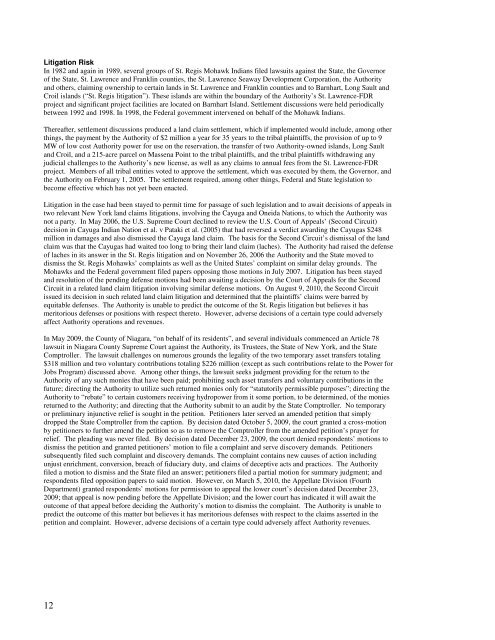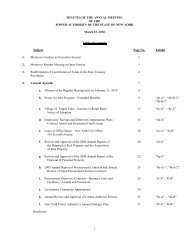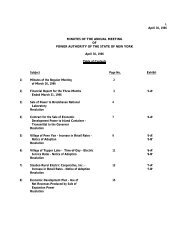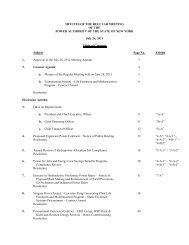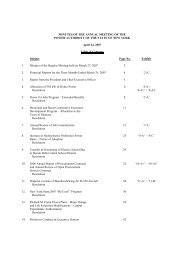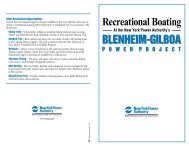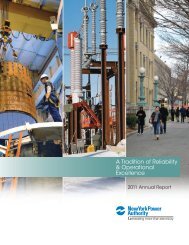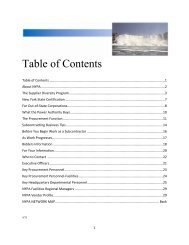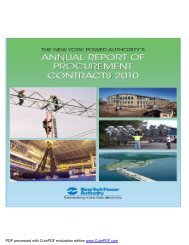PDF - New York Power Authority
PDF - New York Power Authority
PDF - New York Power Authority
You also want an ePaper? Increase the reach of your titles
YUMPU automatically turns print PDFs into web optimized ePapers that Google loves.
Litigation Risk<br />
In 1982 and again in 1989, several groups of St. Regis Mohawk Indians filed lawsuits against the State, the Governor<br />
of the State, St. Lawrence and Franklin counties, the St. Lawrence Seaway Development Corporation, the <strong>Authority</strong><br />
and others, claiming ownership to certain lands in St. Lawrence and Franklin counties and to Barnhart, Long Sault and<br />
Croil islands (“St. Regis litigation”). These islands are within the boundary of the <strong>Authority</strong>’s St. Lawrence-FDR<br />
project and significant project facilities are located on Barnhart Island. Settlement discussions were held periodically<br />
between 1992 and 1998. In 1998, the Federal government intervened on behalf of the Mohawk Indians.<br />
Thereafter, settlement discussions produced a land claim settlement, which if implemented would include, among other<br />
things, the payment by the <strong>Authority</strong> of $2 million a year for 35 years to the tribal plaintiffs, the provision of up to 9<br />
MW of low cost <strong>Authority</strong> power for use on the reservation, the transfer of two <strong>Authority</strong>-owned islands, Long Sault<br />
and Croil, and a 215-acre parcel on Massena Point to the tribal plaintiffs, and the tribal plaintiffs withdrawing any<br />
judicial challenges to the <strong>Authority</strong>’s new license, as well as any claims to annual fees from the St. Lawrence-FDR<br />
project. Members of all tribal entities voted to approve the settlement, which was executed by them, the Governor, and<br />
the <strong>Authority</strong> on February 1, 2005. The settlement required, among other things, Federal and State legislation to<br />
become effective which has not yet been enacted.<br />
Litigation in the case had been stayed to permit time for passage of such legislation and to await decisions of appeals in<br />
two relevant <strong>New</strong> <strong>York</strong> land claims litigations, involving the Cayuga and Oneida Nations, to which the <strong>Authority</strong> was<br />
not a party. In May 2006, the U.S. Supreme Court declined to review the U.S. Court of Appeals’ (Second Circuit)<br />
decision in Cayuga Indian Nation et al. v Pataki et al. (2005) that had reversed a verdict awarding the Cayugas $248<br />
million in damages and also dismissed the Cayuga land claim. The basis for the Second Circuit’s dismissal of the land<br />
claim was that the Cayugas had waited too long to bring their land claim (laches). The <strong>Authority</strong> had raised the defense<br />
of laches in its answer in the St. Regis litigation and on November 26, 2006 the <strong>Authority</strong> and the State moved to<br />
dismiss the St. Regis Mohawks’ complaints as well as the United States’ complaint on similar delay grounds. The<br />
Mohawks and the Federal government filed papers opposing those motions in July 2007. Litigation has been stayed<br />
and resolution of the pending defense motions had been awaiting a decision by the Court of Appeals for the Second<br />
Circuit in a related land claim litigation involving similar defense motions. On August 9, 2010, the Second Circuit<br />
issued its decision in such related land claim litigation and determined that the plaintiffs’ claims were barred by<br />
equitable defenses. The <strong>Authority</strong> is unable to predict the outcome of the St. Regis litigation but believes it has<br />
meritorious defenses or positions with respect thereto. However, adverse decisions of a certain type could adversely<br />
affect <strong>Authority</strong> operations and revenues.<br />
In May 2009, the County of Niagara, “on behalf of its residents”, and several individuals commenced an Article 78<br />
lawsuit in Niagara County Supreme Court against the <strong>Authority</strong>, its Trustees, the State of <strong>New</strong> <strong>York</strong>, and the State<br />
Comptroller. The lawsuit challenges on numerous grounds the legality of the two temporary asset transfers totaling<br />
$318 million and two voluntary contributions totaling $226 million (except as such contributions relate to the <strong>Power</strong> for<br />
Jobs Program) discussed above. Among other things, the lawsuit seeks judgment providing for the return to the<br />
<strong>Authority</strong> of any such monies that have been paid; prohibiting such asset transfers and voluntary contributions in the<br />
future; directing the <strong>Authority</strong> to utilize such returned monies only for “statutorily permissible purposes”; directing the<br />
<strong>Authority</strong> to “rebate” to certain customers receiving hydropower from it some portion, to be determined, of the monies<br />
returned to the <strong>Authority</strong>; and directing that the <strong>Authority</strong> submit to an audit by the State Comptroller. No temporary<br />
or preliminary injunctive relief is sought in the petition. Petitioners later served an amended petition that simply<br />
dropped the State Comptroller from the caption. By decision dated October 5, 2009, the court granted a cross-motion<br />
by petitioners to further amend the petition so as to remove the Comptroller from the amended petition’s prayer for<br />
relief. The pleading was never filed. By decision dated December 23, 2009, the court denied respondents’ motions to<br />
dismiss the petition and granted petitioners’ motion to file a complaint and serve discovery demands. Petitioners<br />
subsequently filed such complaint and discovery demands. The complaint contains new causes of action including<br />
unjust enrichment, conversion, breach of fiduciary duty, and claims of deceptive acts and practices. The <strong>Authority</strong><br />
filed a motion to dismiss and the State filed an answer; petitioners filed a partial motion for summary judgment; and<br />
respondents filed opposition papers to said motion. However, on March 5, 2010, the Appellate Division (Fourth<br />
Department) granted respondents’ motions for permission to appeal the lower court’s decision dated December 23,<br />
2009; that appeal is now pending before the Appellate Division; and the lower court has indicated it will await the<br />
outcome of that appeal before deciding the <strong>Authority</strong>’s motion to dismiss the complaint. The <strong>Authority</strong> is unable to<br />
predict the outcome of this matter but believes it has meritorious defenses with respect to the claims asserted in the<br />
petition and complaint. However, adverse decisions of a certain type could adversely affect <strong>Authority</strong> revenues.<br />
12


